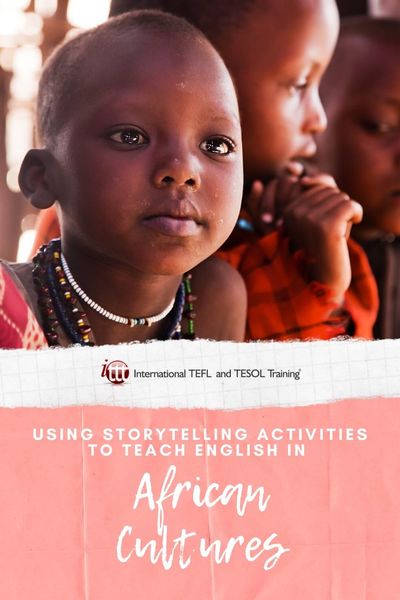Using Storytelling Activities to Teach English in African Cultures

Storytelling is used in the African culture to teach morals, values, historical lessons, and to communicate truths to all ages. Because words are highly valued by Africans, a skilled storyteller is viewed as an influential leader in a community, able to give wise advice. Since the method of storytelling is so widely used in African cultures for instruction, why not integrate it into teaching English to African students as a foreign language?
Table of Contents
Positive Influence on Child Development
Do you want to teach English abroad? Take a TEFL course!
This post was written by our TEFL certification graduate Stanislav T. Please note that this blog post might not necessarily represent the beliefs or opinions of ITTT.
Teaching Linguistic Skills
Storytelling is an effective way to reach both the heart and mind. When a teacher tells her students a story in English, students will easily engage with the story and remember it. Stories enable teachers to introduce vocabulary as simple or complex as desired while exposing the students to correct pronunciation and grammar usage. Storytelling can also be a holistic approach to teaching language. Rather than memorizing vocabulary lists that are disconnected from context, students are given the opportunity through stories to hear and understand new terminology in a concrete way that is correlated with real life.

Also Read: Do TEFL teachers need a second language?
Level of Attention
Audience involvement is highly valued in the traditional African culture of storytelling. A skilled storyteller doesn't monologue her way through a story but instead engages her audience through questions, riddles, choral repetition, and call and response. However, words aren't the only tool that a storyteller will utilize to entertain and teach her audience. Song, costume, instruments (especially drums), facial expressions, and gestures are all used to communicate during a story. These methods can also be a powerful tool for teaching English through storytelling.
Practical Mistakes
In a classroom setting where the teacher is utilizing storytelling with her students, the teacher may pause at any point in the story to ask the students, "Do you know?" when referencing potentially new or unknown vocabulary. For example, if the story told includes an uncle, but the students are not familiar with the word uncle, the teacher may simply pause and ask "Do you know 'uncle'? He is your mother or father's brother." The teacher may then continue to carry on with her story. Because the uncle is bound to come into the story again, students will experience repetition with this new term and consequently store the information in their long-term memory for language.

Also Read: TEFL as an Opportunity for Non-Native Speakers to Explore the World
Positive Influence on Child Development
Because music is such a part of African storytelling and it also engages the brain's memory for language, the inclusion of the song in the classroom can be a potent method for teaching English. Adding a simple English song into the story, repeating it, and inviting the students to join in singing can be a wonderful, light-hearted, and refreshing tool for a teacher to add to her resources for teaching. Choral repetition is commonly used in African storytelling, which can involve chanting a new word or phrase in English and inviting the students to repeat the term until their pronunciation is accurate.
Similar to the song and choral repetition, another tool that classroom storytellers can utilize is call and response. This often will take on the form of a rhythm, where a teacher calls out part of the story using a beat and the students respond to the rhythm with their answer.
Also Read: Where are the best places to teach English abroad?
Tools of Storytelling
Three additional tools for storytelling in the classroom that are not found in traditional African storytelling include student narration, the usage of cloze techniques, and reenacting. After a teacher has told her story, she may invite students to turn in pairs and retell the story to each other. This is sometimes called student narration and it encourages the students to communicate in English in a low-pressure setting. Students are not required to retell the whole story word for word as they heard it, but to simply share in their own words what they remember from the story.

Lesson Plan
A cloze procedure requires students to supply information that has been systematically deleted from a text. While the cloze technique is often seen in worksheets, it can be used in a storytelling setting when a teacher retells the same story a second time, intentionally leaving out pieces of the story and inviting the class to contribute to the story by adding information that is being omitted. A teacher may do this by using three approaches, first by asking questions (i.e. "Do you remember where the uncle lived?"), secondly by pausing for students to contribute (i.e. "They went to the uncle's home, which was…?"), and finally by intentionally inserting opposite or incorrect information than what was initially given in the story and invite the students to correct the teacher with accurate details (i.e. "Then they went to the grandmother's home, right?"). Students engage well with this type of activity, which grows their long-term memory for language and also builds rapport between the teacher and students.
For an activate activity, students may be invited to divide into small groups and prepare a skit to reenact the story together before the class. These usages of questions, song, choral repetition, call and response, student narration, cloze techniques, and reenacting will elicit the involvement of everyone in the classroom and are practical tools for the engage, study, and activate phases of a class.
Do you want to teach English abroad? Take a TEFL course!
Starting with a story before moving to the board for diagram work provides a whole picture of language for students and gives them context for eventually learning the form and structure of the English language. Additional study may include analyzing sentence structure from the story on the whiteboard, studying verbs from the story ("What did the people do?"), discussing grammatical rules found in the story, etc.
Apply now & get certified to teach english abroad!
Speak with an ITTT advisor today to put together your personal plan for teaching English abroad.
Send us an email or call us toll-free at 1-800-490-0531 to speak with an ITTT advisor today.
Related Articles:
- The Top 5 Places to Teach English in Brazil
- Top 10 Places to Take Your TEFL Course in Winter
- Why Taking a TEFL Course Is Highly Beneficial
- 5 Great Destinations for Surfers to Teach English Abroad
- How Teaching English In Brazil Inspired Me To Take My TEFL and Pursue A Teaching Career
- What I've Learned From My TEFL Course in Business English




